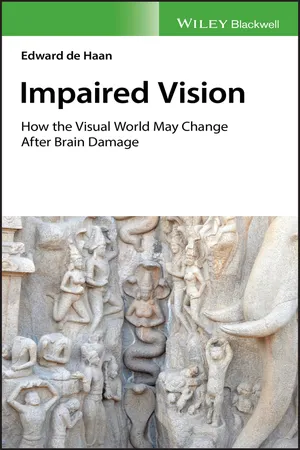Psychology
Visual Anatomy
Visual anatomy refers to the study of the structure and organization of the visual system, including the eyes and the brain regions involved in processing visual information. It encompasses the understanding of how visual stimuli are received, transmitted, and interpreted by the brain. This knowledge is crucial for understanding perception, cognition, and the impact of visual impairments on psychological functioning.
Written by Perlego with AI-assistance
Related key terms
Related key terms
1 of 4
Related key terms
1 of 3
3 Key excerpts on "Visual Anatomy"
- eBook - ePub
Impaired Vision
How the Visual World May Change after Brain Damage
- Edward de Haan(Author)
- 2019(Publication Date)
- Wiley-Blackwell(Publisher)
The perception of touch or pain relies on an intricate system of peripheral and central nerves, with different aspects of the somatosensory perception being processed in different quarters of the brain. This is certainly also true for vision. We now know that the act of seeing, in all its complexity, is carried out by a large network of subsystems that encompass a substantial part of the brain. If we rewind the tape, and revisit all the different disorders that may occur, it is clear that vision is a lot more than a sensory organ relaying its information to a central agent in the brain. It is obvious that, when we consider the complexity of looking at a blue sky, of seeing a tree, of recognizing a face, or of all the other visual abilities that we possess, a simple, single location for vision on the brain is unrealistic. Coming back to the philosophers and their meeting on the origins of pain, the answer to their scholarly conundrum for the visual system is clear. Given that the retina, per definition, is part of the brain, vision is definitely in the brain, or more like the whole brain.The visual impairments that I have described in this book constitute only a subset of an even wider range of clinical deficits that are now known. I have tried to select a number of exemplary disorders in the visual domain, not only to demonstrate the stunning variety of problems that may occur, but also to provide some insights into the personal stories behind the clinical diagnoses. In this last chapter, I will try to distill the main, overall lessons that I have learned from the clinical exploration of patients with visual impairments.9.1 Scope of the Visual Brain
Psychophysiological experiments using micro‐electrodes have a long history, spanning more than 5 decades of research. As the techniques have improved, it has become possible to investigate the functional architecture of the brain in more detail. There is now, for example, evidence for more than 40 visual maps or areas in the macaque monkey. Together, these maps or visual areas cover some 50% of the monkey's cortex. As suggested in Chapter 1 - eBook - ePub
Television Aesthetics
Perceptual, Cognitive and Compositional Bases
- Nikos Metallinos(Author)
- 2013(Publication Date)
- Routledge(Publisher)
4 Anatomy of the Human Information SystemThe organs of visual and auditory perception, the eyes and ears, constitute a complex information system, a network of stations that receive selected signals from the environment either electromagnetically or mechanically (by air vibration), transform them into organized bits of information or codes, and channel them by electrical impulses to the brain. In the brain, these codes are then processed to the appropriate part depending on their nature and particular characteristics where they are decoded, translated, recognized, and assume their meaning. Oversimplified, this is how perception and cognition work.This chapter describes and exemplifies these processes pertaining to visuals and sounds, both inherent in televised images. Specifically examined are the neurophysiological factors of the information centers (the eyes, ears, and brain), the threefold perceptual process, and the codification of visual and auditory information.NEUROPHYSIOLOGICAL FACTORS OF THE EYE, EAR, AND BRAINTo understand how the complex human information networks work, basic preliminary information about the anatomy of these organs is needed. A detailed explanation of the neurophysiology of each part of these three information networks is beyond the scope of this chapter. Instead, the discussion refers to the key stations of each of the three systems involved in the reception, organization, and recognition of visual and auditory signals. The principles of cognition as they relate to visual images in general, and to television images in particular, are underlined. Of particular importance to students of visual literacy are three key factors that relate to the human information organs: duplication, polarization, and interconnection of the eyes, ears, and brain.Like most other organs of the human body the eyes, ears, and brain are duplicated in the left and right side of a person’s head. In our routine activity of receiving and processing images and sounds, the fact that two identical yet separate eyes, ears, and brains are in operation seldom draws our attention. This duplication - eBook - ePub
- Irving B. Weiner, Randy J. Nelson, Sheri Mizumori(Authors)
- 2012(Publication Date)
- Wiley(Publisher)
Chapter 4 Visual Processing in the Primate Brain Chris I. Baker Visual Processing Basics The Retina Lateral Geniculate Nucleus (LGN) Visual Areas in Primate Cerebral Cortex Visual Topographic Maps V1—Primary Visual Cortex V2 Major Cortical Visual Processing Pathways Ventral Pathway Dorsal Pathway Lateral Intraparietal Area (LIP) Concluding Remarks ReferencesVision is the most widely studied and dominant sensory system in human and nonhuman primates. Of the total surface area of the cerebral cortex roughly 50% in macaque monkey, and 20 to 30% in human, is largely or exclusively involved in visual processing (Van Essen, 2004; Van Essen & Drury, 1997). Intensive study of vision in nonhuman primates, and particularly the macaque, has produced a detailed anatomical and functional description of processing at many levels of the neural visual pathway. In the past 20 years, the advent and development of functional brain imaging, and in particular functional Magnetic Resonance Imaging (fMRI), has enabled the detailed study of cortical, and in some cases subcortical, visual processing in humans. This chapter will synthesize findings from both human and nonhuman primates toward an understanding of the visual processing stream.Visual Processing Basics
Vision is the process of extracting information about the external world from the light reflected or emitted by objects and surfaces. How light is reflected off an object or surface is determined by many factors including orientation, texture, movement, and absorbance. Thus, the reflected light carries information about those objects or surfaces and interpreting its pattern can aid an organism in interacting effectively with its environment. As an evolved biological system, the goal of vision is not to produce a veridical description of the external world but a description that facilitates adaptive behavior. Those aspects of the input that contain information critical for behavior will be emphasized and those aspects that carry little information will be discarded.
Index pages curate the most relevant extracts from our library of academic textbooks. They’ve been created using an in-house natural language model (NLM), each adding context and meaning to key research topics.
Explore more topic indexes
Explore more topic indexes
1 of 6
Explore more topic indexes
1 of 4


